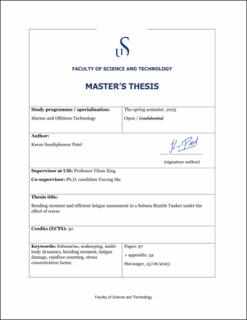| dc.description.abstract | The subsea shuttle tanker (SST) is the next-generation autonomous submarine designed to transport liquid CO2 from land/offshore facilities to the smaller fields for injection. Unlike normal shuttle tankers, which are highly weather dependent, the SST can carry out freight operations in all weather conditions because it travels underwater between 40 m and 70 m water depth.
The first part of the thesis proposes a fast, efficient and reliable multi-body approach to determine the bending moment response of the SST hull at 40 m and 70 m water depth. The chosen approach is based on the discrete-module-beam bending-based hydroelasticity principle. The flexible hull of the vessel is divided into several multi-body rigid modules. All the hydrodynamic and hydrostatic forces are applied to the center of gravity of each rigid module. The parametric models, like the state-space model system, are used to compute the free-surface memory effect more effectively. The multi-body equation of motion is solved to determines the bending moment response of an interconnected multi-body rigid module. The numerical model is prepared using Matlab Simulink to study the dynamics of the vessel. A convergence study is conducted to select the optimal number of bodies needed to perform this study. The result shows that the lower number of bodies (i.e., three and five bodies) does not have enough points to capture all the wave encounter frequencies, thus underestimating the bending moment. Therefore, seven-body SST is used to carry out a further assessment. The bending moment standard deviation is reduced by approximately 50 % when SST travels at 70 m water depth instead of 40 m.
The second part of the thesis presents the fatigue assessment of the SST hull, considering the stiffeners' local details. Two FE models (2D axisymmetric and 3D shell element models) representing the local detail of the flooded-mid body of the SST are prepared to determine the stress concentration factor (SCF). The resultant SCF can be given using the superposition concept by taking the product of the SCF for the individual models. The Rainflow counting method and Palmgren-Miner rule are used to calculate the accumulated fatigue damage and fatigue life. The numerical results show that the impact of long waves has contributed to the most damage to the vessel. The minimum fatigue life at the flooded-mid section is 13 and 19 years for the 40 m and 70 m water depths, respectively. The results also shows that fatigue life due to the change in hydrostatic pressure during dive-in and dive-out is five years. | |
